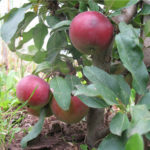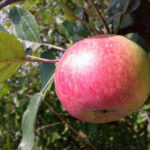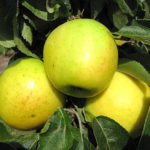Apple variety Red Chief
In America, as well as in Russia, apple trees are the leading fruit crop, for which considerable areas are allotted. American breeding has given the world beautiful and recognizable varieties such as Delicious, Red Delicious, Jonathan and many others. Moreover, most of them served as the basis for the creation of new, no less well-known varieties. So, for example, the Red Chief variety, beloved by Russians, is a clone of the Red Delicious apple tree. Various sources offer their own versions of the origin of this variety. Some argue that the Red Chief appeared in West Virginia as a result of accidentally sowing the seeds of a hybrid obtained from crossing Golden Reinet and Grims Golden. Others name Jonathan and Wagner as the original forms, although, as you know, they are the parents of another celebrity - the apple tree Idared... Despite the fact that our hero has a long history, since it was introduced to the horticultural community back in 1914, it was entered into the State Register of Breeding Achievements of Russia only in 2016. Its applicant and originator was LLC Agrofirma Sad-Giant, located in the Krasnodar Territory. After variety trials, Red Chief was approved for cultivation in the Central Black Earth District and the North Caucasus region. Our hero, due to its unique characteristics, is used not only in private gardening, it is perfect for intensive cultivation. For example, on the territory of Ukraine, it is cultivated almost everywhere. For many gardeners, the described variety is very reminiscent of the once widespread in the USSR, but now a half-forgotten variety of German breeding Richard.
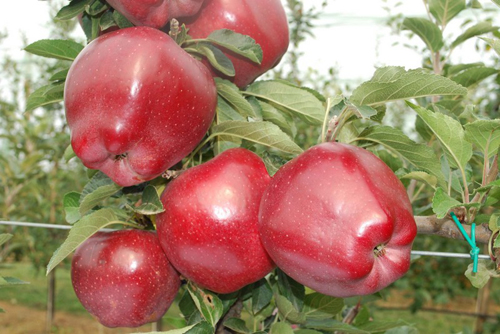
Description
The plant is fast growing. According to the State Register, the tree is large, some sources describe the height of 6 - 7 m. According to other information, its size can be called weak or medium-sized. Crohn narrow-pyramidal, close to spuric species, medium thickening. Skeletal branches are curved, compactly located, depart from the trunk at an angle close to a straight line, the ends of the branches are directed upward. The annual growth rate is 5 - 7 cm. Shoots with short internodes, greenish-brown bark, small, slightly convex, light-colored lentils. The foliage is good. Leaves are green, medium-sized, elongated, short-pointed apex, arcuate base, serrate-crenate edges. The surface of the leaf blade is smooth, matte, with gentle nerve, the edges are raised. The petiole is long, thin, uncolored; stipules are subulate. The flowers are white and pink. The crop is formed on ringlets, which are formed in large quantities.
The fruits of the Red Chief can rightfully be considered the benchmark, because one can hardly walk indifferently by the bright apples lying on the counter. They are distinguished by large-fruited, one-dimensional, excellent oblong-conical shape. In inheritance from Red Delicious, our hero inherited a recognizable strong and wide-ribbed surface. The weight of an apple according to the State Register is 175 g, according to other sources - from 200 to 400 g. The skin is strong, but not hard, smooth, glossy and shiny. The main color is green, the integumentary color occupies most of the surface in the form of a blurred striped blush of a saturated red color. The subcutaneous points are light, medium-sized, numerous. The entire surface of the fruit is covered with a thick translucent waxy coating. The funnel is of medium size, blunt-conical in shape; there are no traces of rusting. The saucer is generally deep, of medium width. Our hero is characterized by the presence of five large protruding hills, bordering the pericellular depression. The calyx is large, half open. The sub-cup tube is deep, conical. The seed chambers are small, oblong, closed. The seeds are brown. The peduncle is short, thick, curved.The pulp is greenish, fine-grained, prickly, medium density, not too coarse, medium juiciness. The aroma is moderately pronounced. The taste is excellent, sweet, slightly bland. Although some tasters claim that a slight sourness is still present. Evaluation of palatability 4.7 - 4.8 points. 100 g of raw pulp contains: dry matter 14.0%, sugars 10.6%, acid 0.4%, vitamin C 5.5 mg%.

Characteristics
- The early maturity of the Red Chief apple tree allows you to get a harvest already 2 or 3 years after planting. True, it should be noted that the culture will show such results on low-growing and medium-sized rootstocks. On a strong rootstock, the harvest will have to wait longer;
- the plant blooms in mid-May;
- in terms of ripening, the State Register classifies our hero as an autumn species. But other sources claim that the variety is winter. The beginning of the harvest falls, depending on the region, in the middle or the end of September. The harvest period can take up to 3 weeks, which indicates uneven ripening of the fruit;
- immediately after picking, do not rush to draw conclusions about the taste of the culture. The crop must mature a little in order to gain the required taste conditions. The consumer period will only start at the end of November or December;
- the productivity of the tree is very high. True, in the first years of fruiting, about 30 kg can be obtained from one tree. But in the future, this indicator increases, and at the peak of productivity, 120 - 150 kg are already removed from the apple tree. The average yield according to the State Register is 380 c / ha;
- the duration of the productive period is more than 25 years;
- the yield cannot be called stable, since the culture still tends to be periodic. The main threat to yield decline is represented by unstable weather conditions: drought at the time the buds of the future harvest are laid or large temperature drops in winter;
- winter hardiness is average, but quite suitable for regions of tolerance. A mature tree can withstand temperatures as low as minus 25 ° C in winter. But the seedling still needs to be insulated. By the way, there is evidence that with competent agricultural technology, our hero shows good results even in cooler regions, for example, in Novosibirsk;
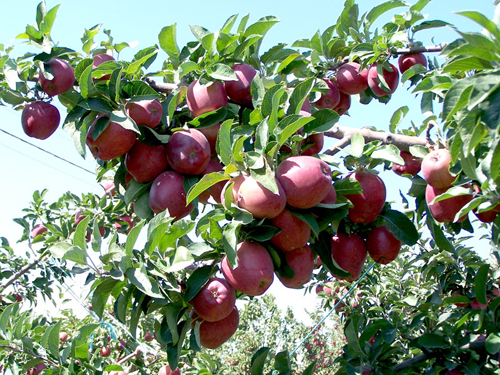
- The State Register calls the Red Chief resistant to diseases and pests, but does not provide specific data. Other sources speak of average immunity. The variety has good resistance to powdery mildew and fire blight. Resistance to scab is weak. In addition, the fruits can be affected by bitter pitting (bitter spot), vitreousness (mainly when the crop is harvested with a delay), and rot. According to reviews, the bark of the trunk often suffers from sunburn, which is well protected by spring whitewashing;
- the variety is moderately resistant to drought. In a particularly hot period, the tree needs additional moisture. The State Register, however, notes a high degree of heat resistance and drought resistance;
- transportable characteristics at the highest level. It is not for nothing that fruits, resistant to various mechanical damage, easily transfer travel from one continent to another;
- keeping quality is one of the main trump cards of the variety. With proper storage, the fruits retain the highest marketability and taste for 8 months. But some gardeners say that if stored improperly, the middle of the apple becomes loose;
- the main purpose of the crop is to use it in its natural form. Moreover, the appearance and taste of the variety allow you to use apples for the preparation of delicious and beautiful desserts, for example, sweet fruit salads. The pulp goes well with honey, nuts, soft cheese. The fruits are good when baked.
Pollinators
Despite the high productivity, the Red Chief does not differ in self-fertility. In order to maintain such a high level of yield, our hero must have reliable pollinators. The most suitable flowering times are Gloucester, Golden Delicious, Elstar.
The big plus of our hero is the ability to grow it using the technology of compacted planting. This is largely due to the compact crown. The most successful rootstocks for culture are M9 and MM106. So, for example, on the M9 rootstock, an apple tree can be grown using a trellis method, which makes it easy to care for the tree and easily harvest.
Agrotechnics
The best time for planting the Red Chief in the regions of admission is autumn, 2 - 3 weeks before the onset of stable cold weather. But you do not need to limit yourself to this period, if for some reason the landing did not take place, then it can be postponed to the spring. The site should be well lit and easily blown out during the growing season, so that excessive moisture in rainy weather does not become a favorable background for the development of fungal infections. But from a strong wind, especially in winter, the planting site of our hero should be fenced off, since the root system of dwarf rootstocks is located in the upper layers of the soil and is not able to hold the apple tree under the pressure of a strong wind. In this regard, the MM106 rootstock is able to provide better anchoring and relieve the plant from the need for support. Watering is carried out taking into account the precipitation, but with the condition that the soil in the near-trunk circle should be in a moderately moist state. It is especially necessary to strictly follow the schedule of seedlings moisturizing. Top dressing is carried out according to the standard scheme, you can combine organic matter and mineral fertilizers. Preventive spraying against diseases and pests carried out in time will increase the plant's resistance.
Red Chief is another commercial variety from the USA. But he perfectly settled down on the territory of Russia and enjoys a well-deserved respect among gardeners. The apple tree looks quite decorative in spring and autumn, is small in size, suitable for industrial cultivation. The main advantages of the variety are early maturity, large size, high marketability and taste of fruits, keeping quality. Winter hardiness is insufficient for growing apple trees in cool regions, but quite suitable, for example, for the Moscow region. If the variety is grown in intensive gardens, then scab protection will need to be carried out in an enhanced mode. Despite this, the long-liver from America is a welcome acquisition for most gardeners and is actively used in industrial plantings.


